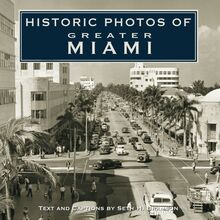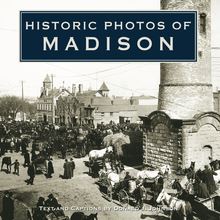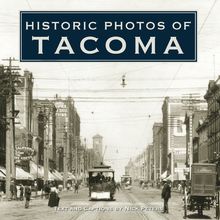Historic Photos of Gainesville , livre ebook
198
pages
English
Ebooks
2008
Vous pourrez modifier la taille du texte de cet ouvrage
Obtenez un accès à la bibliothèque pour le consulter en ligne En savoir plus
Découvre YouScribe en t'inscrivant gratuitement
Découvre YouScribe en t'inscrivant gratuitement
198
pages
English
Ebooks
2008
Vous pourrez modifier la taille du texte de cet ouvrage
Obtenez un accès à la bibliothèque pour le consulter en ligne En savoir plus
Publié par
Date de parution
01 avril 2008
Nombre de lectures
1
EAN13
9781618586315
Langue
English
Poids de l'ouvrage
8 Mo
Nearly 200 years ago, settlers arrived in Alachua County to grow cotton and other crops. By the middle of the nineteenth century, enough people resided in the area today known as Gainesville that they decided to create a town to be the center of business and government for the county.
In 1906, the focus changed with the arrival of the University of Florida. Although it then barely exceeded a hundred students, it has grown to be one of the nation’s largest universities and has gained national prominence as a leading research institution.
Historic Photos of Gainesville showcases nearly 200 black-and-white images to chronicle the growth of the city from a place where pigs, cows, and chickens ran free, to a modern city where cutting-edge research is routine.
Publié par
Date de parution
01 avril 2008
Nombre de lectures
1
EAN13
9781618586315
Langue
English
Poids de l'ouvrage
8 Mo
HISTORIC PHOTOS OF
GAINESVILLE
T EXT AND C APTIONS BY S TEVE R AJTAR
In 1918, the University of Florida s YMCA acquired 20 acres along Lake Wauberg, located south of the campus, for student recreational activities. The land was transferred to the university in 1928 and a recreation center was built in 1939. This photo of a family enjoying a day at the lake, possibly Lake Wauberg, was taken in 1962.
HISTORIC PHOTOS OF
GAINESVILLE
Turner Publishing Company
200 4th Avenue North Suite 950
Nashville, Tennessee 37219
(615) 255-2665
www.turnerpublishing.com
Historic Photos of Gainesville
Copyright 2008 Turner Publishing Company
All rights reserved.
This book or any part thereof may not be reproduced or transmitted in any form or by any means, electronic or mechanical, including photocopying, recording, or by any information storage and retrieval system, without permission in writing from the publisher.
Library of Congress Control Number: 2007941401
ISBN-13: 978-1-59652-433-0
Printed in China
09 10 11 12 13 14 15-0 9 8 7 6 5 4 3 2
C ONTENTS
A CKNOWLEDGMENTS
P REFACE
E ARLY D AYS (1860 S -1899)
B ECOMING A C OLLEGE T OWN (1900-1919)
G ROWTH OF THE C ITY AND THE U NIVERSITY (1920-1939)
M ODERN G AINESVILLE (1940-1970 S )
N OTES ON THE P HOTOGRAPHS
Gainesville resident Dudley Reed was a master violin maker, and the instruments he crafted during the 1950s are prized by collectors today. He used maple for the back, sides, neck, and scroll, and spruce for the top. The story of his life is recounted in Dudley Reed, Fiddle Maker: A Memorial by Howard Reed.
A CKNOWLEDGMENTS
This volume, Historic Photos of Gainesville , is the result of the cooperation and efforts of many individuals and organizations. It is with great thanks that we acknowledge the valuable contribution of the Florida State Archives for their generous support.
P REFACE
Today s Gainesville is difficult to imagine without the University of Florida. The campus occupies a large portion of the land near downtown. Nearly every business displays Gator logos, the colors of orange and blue, or other images to cater to students and those who work for the university. One might think that the university came first, and then a town grew up around it.
On the contrary, Gainesville existed long before the university moved to town. The University of Florida traces its roots to 1853, but that date refers to one of its parent institutions, which was located in Ocala. The university moved to Gainesville in 1906, when the town was already a bona fide municipality.
Like most of Florida, the area was settled by individuals engaged in agriculture. Various industries later located there and, unlike much of the state, tourism never assumed a position of primary importance. From the early days, the town has had a broad-ranging reputation for education.
Its schools attracted students from several regions. The Gainesville Academy was founded in 1856 for white students and the Union Academy began a decade later for black students. The educational environment in Gainesville also attracted schools. After the Civil War, the East Florida Seminary arrived and merged with the Gainesville Academy. In 1873, Maggie Tebeau founded a private school with a focus on English and music that lasted for more than 60 years. Chateau-Briant was another well-known institution that helped turn children into well-educated adults.
The biggest coup in the educational field was the merger of several schools to form the University of Florida, and its move to Gainesville. The town was irrevocably changed and now is a world leader in many areas of academia. There is still agriculture, largely as an extension of the university. There is still industry, largely conducted in connection with the university. There is everything an area needs to be a modern city-all connected in some way with the university.
The pages that follow hold images which chronicle more than a century of Gainesville s people, architecture, events, and growth, from its origins as a small distribution center for shipping farm produce to its rise to leadership in research and education.
-Steve Rajtar
This project represents many hours of research. The editors and writer have reviewed hundreds of photographs housed in the Florida State Archives. We greatly appreciate the generous assistance of the individuals and organizations listed in the acknowledgments, without whom this project could not have been completed.
The goal in publishing this work is to provide broader access to these extraordinary images, to inspire, furnish perspective, and evoke insight that might assist those who are responsible for determining the future of Gainesville. In addition, we hope that the book will encourage the preservation of the past with adequate respect and reverence.
With the exception of cropping images where needed and touching up imperfections that have accrued over time, no other changes have been made. The caliber and clarity of many photographs are limited by the technology of the day and the ability of the photographer at the time they were made.
We encourage readers to reflect as they drive or walk the streets of Gainesville, enjoy the beaches and parks, and experience the amenities of this bustling metropolitan area. It is the publisher s hope that in utilizing this work, longtime residents will learn something new and that new residents will gain a perspective on where the region has been, so that each can contribute effectively to its future.
-Todd Bottorff, Publisher
Bordering the north side of Courthouse Square was Alachua Avenue (now known as University Avenue), which in the early days of Gainesville was lined with wooden store buildings. From left to right are the Chris Matheson store, the medical office of Dr. James F. McKinstry, the post office, and the Vidal Drug Store owned by Dr. Adolph J. Vidal. From 1915 until 1921, Dr. McKinstry also served as the postmaster.
E ARLY D AYS
(1860 S -1899)
Settlers began arriving in what is now Gainesville in the mid-1820s, but the county seat was established in Newnansville, to the north. Local farms produced cotton, citrus, and other crops, and it wasn t until the 1850s that there was much interest in establishing a town, which was founded on January 24, 1854.
The first thing the new town needed was a name, and that was left up to the citizens of Alachua County. County commissioner William R. Lewis proposed the name Lewisville. William I. Turner advocated honoring Edmund Gaines, a hero of the First and Second Seminole Wars. The deal made with Lewis was that if he voted for moving the courthouse to the new town and that proposal was rejected (an outcome he fully expected), Lewisville would be the name. To his surprise, the move of the courthouse was approved and Gainesville was adopted as the name.
The town was formally laid out around Courthouse Square, which still dominates downtown Gainesville. The construction of the courthouse in 1854 and the routing of the railroad through the new town drew the county s business away from Newnansville, which is now a ghost town, and motivated many to construct a variety of businesses around the square. The Presbyterian church building was erected in 1859, followed by sanctuaries for the Methodists, Episcopalians, Baptists, and Catholics not long afterward.
The railroad arrived in Gainesville largely to transport crops to market before the Civil War, and the railroad was the reason downtown Gainesville became a battleground. In 1864, Union soldiers followed the tracks into town with the goal of capturing two trains. Although the brief skirmish was won by the invaders, the soldiers left town the next day without the trains. A second battle was fought later that year near the railroad depot, and this time the Confederate defenders prevailed, killing and capturing several and driving off the rest.
Early businesses clung to the roads forming Courthouse Square, an area packed with wooden structures housing doctors, lawyers, blacksmiths, livery stables, hotels, and stores selling groceries, clothing, lumber, medicines, and everything else (sometimes all in the same building). The closely packed buildings made it easy for a farmer or rancher to come to town and do all of his shopping with one stop. They also increased the dangers of an unintended hazard-fire.
The wooden buildings around the square frequently caught fire, and as they were destroyed and needed replacement, brick and concrete became the materials of choice. Today, the only wooden buildings from the nineteenth century that survive are those located in the less-crowded residential areas, blocks or miles from downtown.
Several railroads served Gainesville, and the town became a rail destination not only for people who wanted to do business there, but also for those who wanted to continue southward to areas not accessible by train. Before changing to horses or other transportation, visitors often spent time in the Gainesville hotels and restaurants, supporting the local merchants.
In the 1880s, Gainesville was the state s biggest grower and shipper of sea-island cotton. There was also a strong citrus industry, although not as important as that in counties located farther south. The citrus industry suffered much from freezes in the mid-1890s, then was essentially eliminated from the area by another killing freeze just when replacement trees were about to become productive.
The town isolated itself from the rest of the world in 1888, as did other cities in Florida, when an outbreak of deadly yellow fever threatened the lives of Florida s citizens. Trains were not allowed in. Mail delivery from outside the county was halted. A contingent of Gainesville Guards however, local residents who had formed a military unit to protect the town, were allowed to return from Fernandina, where they had been sent to keep the peace during a longshoremen s strike. The guards brought














